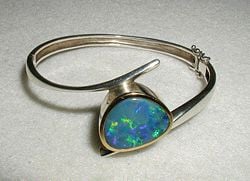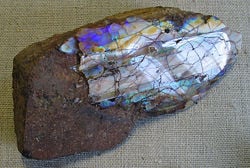Opal
| Opal | |
|---|---|
 A blue opal bracelet. The stone size is 18 by 15 mm (0.7 by 0.6 inch). |
|
| General | |
| Category | Mineraloid |
| Chemical formula | Hydrated silica. SiO2·nH2O |
| Identification | |
| Color | White, black, red, orange, most of the full spectrum, colorless, iridescent. Very infrequently of a singular color |
| Crystal habit | Irregular veins, in masses, in nodules |
| Crystal system | Amorphous |
| Cleavage | None |
| Fracture | Conchoidal to uneven |
| Mohs Scale hardness | 5.5 - 6.6 |
| Luster | Vitreous to resinous |
| Refractive index | 1.44 - 1.46 |
| Pleochroism | Occasionally |
| Streak | White |
| Specific gravity | 2.1 - 2.3 |
| {{{density}}} | |
Opal is one of the mineraloids that can form or replace fossils. The resulting fossils, though not of any extra scientific interest, appeal to collectors because of the stones' myriad combinations of beautiful hues. Coloration can range the full spectrum from white to black and almost everything inbetween. Occurring in most varieties of rock, the vast majority of opals are mined in Australia, with other opal digs occurring in the United States, Mexico, Peru, and Brazil.
Opals range in quality from gemstone, composed of tightly arranged silica spheres producing a unique depth of color, to common opals that have a blander range of coloration due to their gradual formation in wood. Other varieties of opal, ranging from translucent to semi-opaque, round out this remarkably attractive mineraloid.
Occurrence
Opal is a mineraloid gel which is deposited at relatively low temperature and may occur in the fissures of almost any kind of rock, being most commonly found with limonite, sandstone, rhyolite, and basalt.
Opals were relatively rare until the early 1800s, when several rich sources were discovered and the gem quickly grew in popularity.
Australia produces around ninety-seven percent of the world’s opal. Ninety percent is called light opal or white and crystal opal. White makes up sixty percent and all the opal fields produce white opal; Crystal opal or pure hydrated silica makes up thirty percent; eight percent is black and only two percent is boulder opal. The town of Coober Pedy, South Australia (see below) in South Australia is a major source of opal. Another Australian town, Lightning Ridge in New South Wales is the main source of black opal, opal containing a predominantly dark background (dark-gray to blue-black displaying a play of color).
Fire Opal is found mostly in Mexico and Mesoamerica. In Honduras, good quality black opal has been mined from volcanic ash deposits. This opal is known for it's stability. There is also opal in South America. In Brazil the city of Pedro II has produced opal that was discovered in 1930.
The Virgin Valley Opal Fields in northern Nevada produce black, crystal, white, and fire opal. Most precious opals are wood replacemnts. Discovered in 1904, the mines are still producing gem materials in large amounts to hundreds of seasonal visitors. Three fee dig mines provide the public an opportunity to mine the gems themselves. The largest black opal in the Smithsonian Museum comes from these mines.
Another source of white base opal in the United States is Spencer, Idaho. A high percentage of the opal found there occurs in thin layers. As a result, most of the production goes into the making of doublets and triplets.
Characteristics
The mineraloid opal is amorphous SiO2·nH2O; hydrated silicon dioxide, the water content sometimes being as high as twenty percent, but is usually between three and ten percent. Opal ranges from colorless through white, milky blue, gray, red, yellow, green, brown, and black. Common opal is truly amorphous, but precious opal does have a structural element. The word opal comes from the Sanskrit upala, the Greek opallios, and the Latin opalus, meaning "precious stone."
Precious Opal
Precious opal shows a variable interplay of internal colors and does have an internal structure. At the microscale, precious opal is composed of hexagonal or cubic closely packed silica spheres some 150 to 300 nm in diameter. These ordered silica spheres produce the internal colors by causing the interference and diffraction of light passing through the microstructure of opal (Klein and Hurlbut, 1985, p. 444). In addition, microfractures may be filled with secondary silica and form thin lamellae inside the opal during solidification. The term opalescence is commonly and erroneously used to describe this unique and beautiful phenomenon, which is correctly termed play of color. Contrarily, opalescence is correctly applied to the milky, turbid appearance of common or potch opal. Potch does not show a play of color.
The veins of opal displaying the play of color are often quite thin, and this has given rise to unusual methods of preparing the stone as a gem. An opal doublet is a thin layer of colorful material, backed by a black mineral, such as ironstone, basalt, or obsidian. The darker backing emphasizes the play of color, and results in a more attractive display than a lighter potch. Given the texture of opals, they can be quite difficult to polish to a reasonable lustre. The triplet cuts back the colored material with a dark backing, and then has a cap of clear quartz (rock crystal) on top, which takes a high polish, and acts as a protective layer for the comparatively delicate opal.
Common Opal
Besides the gemstone varieties that show a play of color, there are other kinds of common opal such as the milk opal, milky bluish to greenish; resin opal, honey-yellow with a resinous lustre; wood opal, caused by the replacement of the organic material in wood with opal; menilite brown or grey; hyalite, a colorless glass-clear opal sometimes called Muller's Glass; geyserite, (siliceous sinter) deposited around hot springs or geysers; and diatomite or diatomaceous earth, the accumulations of diatom shells or tests.
Other Varieties
Boulder Opal consists of concretions and fracture fillings in a dark siliceous ironstone matrix. It is found sporadically in western Queensland, Australia, from Kynuna in the north, to Yowah and Koroit opal field in the south.
Black Opal, containing a predominantly dark background (dark-gray to blue-black) displaying a play of color.
Fire opal is a translucent to semi-opaque stone that is generally yellow to bright orange and sometimes nearly red and displays pleochroism (property of certain crystals of exhibiting different colors when viewed from different directions under transmitted light) at certain angles.
Peruvian opal (also called blue opal) is a semi-opaque to opaque, blue-green stone found in Peru which is often cut to include the matrix in the more opaque stones. It does not display pleochroism.
Synthetic Opal
As well as occurring naturally, opals of all varieties have been synthesized experimentally and commercially. The discovery of the ordered sphere structure of precious opal led to its synthesis by Pierre Gilson in 1974 (Klein and Hurlbut, 1985, p.528). The resulting material is distinguishable from natural opal by its regularity; under magnification, the patches of color are seen to be arranged in a "lizard skin" or "chicken wire" pattern. Synthetics are further distinguished from naturals by the former's lack of fluorescence under UV light. Synthetics are also generally lower in density and are often highly porous; some may even stick to the tongue.
Two notable producers of synthetic opal are the Kyocera and Inamori companies of Japan. Most so-called synthetics, however, are more correctly termed imitations, as they contain substances not found in natural opal (e.g., plastic stabilizers). The imitation opals seen in vintage jewellery are often "Slocum Stone" consisting of laminated glass with bits of foil interspersed.
Cultural Significance
- Opals are widely used in jewelry. The play of color displayed by some opals makes them popular for use in "mood rings," which are supposed to reflect the emotional state of the wearer.
- Opal is believed by some to possess healing powers. Its reported powers include the ability to alleviate depression and help its wearer find their true love.
- Opals are supposed to enhance the positive characteristics of people born under the zodiac sign of Cancer. Black opal is recommended for those born under the sign of Scorpio, and Boulder opal brings good fortune for people born under Aries.
- Opals were particularly popular in the Art Deco era, when gemstone artists preferred them to all other stones.
- The opal is the official gemstone of South Australia and the Commonwealth of Australia, and the country's Australia Women's National Basketball Team is nicknamed The Opals.
- Opal is the official birthstone of the month of October.
- The state gem stone for Nevada is precious black opal, found in Virgin Valley, Humboldt County, Nevada.
- Opal is a popular woman's name.
The Town of Coober Pedy
The "Opal Capital of the World" is found deep in the outback of South Australia. The town of Coober Pedy began in 1915 when a teenager overturned a "Surface Opal Nobbie" while gold prospecting with his father. Today, nearly half of the town has burrowed underground to escape the surface heat which can hit 135 degrees F. This population lives in affordable, underground homes called "dugouts," which remain a cool 72 degree F. year round. Many opal producing fields are located within a 24-mile radius of the town. Tourists enjoy strolling the area which has been compared to a "lunar landscape," and occasionally they kick up an opal, just the way the town's founding son did. (Coober Pedy is an aboriginal term meaning "White man's burrow.")
Refereneces
- Downing, Paul. Opal Identification & Value. Gem Guides Book Company; 2nd edition, 2002. ISBN 9780962531187
- Eckert, Allan. The World of Opals. John Wiley & Sons, 1997. ISBN 9780471133971
- Klein, Cornelis, and Hurlbut, Cornelius S. Manual of Mineralogy, 21st ed., John Wiley & Sons Inc; 21st edition, 1993. ISBN 978-0471574521
- Ward, Fred. Opals. Gem Guides Book Company, 2000. ISBN 978-1887651042
External Links
- Opal, Colored Gemstone Association, retrieved February 2, 2007
- Opal Mining in South Australia, PIRSA Minerals, retrieved February 2, 2007
- Photos and other Information on Opals, University of California at Berkeley Socrates Project, retrieved February 2, 2007
- Scientific Data on Opals Lawrence Livermore National Laboratory retrieved February 2, 2007
- Virgin Valley Opals, Swordfish Mining Co. retrieved February 2, 2007
Credits
New World Encyclopedia writers and editors rewrote and completed the Wikipedia article in accordance with New World Encyclopedia standards. This article abides by terms of the Creative Commons CC-by-sa 3.0 License (CC-by-sa), which may be used and disseminated with proper attribution. Credit is due under the terms of this license that can reference both the New World Encyclopedia contributors and the selfless volunteer contributors of the Wikimedia Foundation. To cite this article click here for a list of acceptable citing formats.The history of earlier contributions by wikipedians is accessible to researchers here:
The history of this article since it was imported to New World Encyclopedia:
Note: Some restrictions may apply to use of individual images which are separately licensed.


